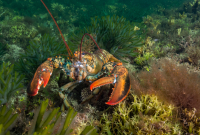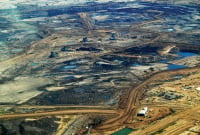Support strong Canadian climate journalism for 2025
When Alden Gaudet pulled into Tignish Harbour on Prince Edward Island, other fishers could hardly believe their eyes.
He’d had a successful day fishing snow crab, a crustacean that thrives in cold Atlantic waters, which wouldn’t typically be notable. However, last year when Gaudet made his way back to land with his catch, it coincided with a fishery closure due to a right whale sighting. When the endangered creatures are spotted, there’s a pause on the use of roped gear in the area. The closures specifically affect fisheries that use fixed gear, such as crab and lobster traps, which are dropped in the ocean and gathered later. In between deployment of the traps and harvesting, fishing lines run parallel from the sea floor to buoys on the ocean’s surface, which leads to whales getting entangled.
Gaudet could still fish in the area because he’d used whale-safe ropeless gear, which is still allowed during a closure. He borrowed it for free through a gear-lending program called CanFish, based in Halifax and administered by the Canadian Wildlife Federation. The program, the first of its kind in Canada, started in 2022 with funding from the federal government and is now in its second year of operation. However, the program hasn’t secured government funding for the upcoming year.

There are variations on the type, but generally, ropeless gear does not use a buoy and a line. Instead, a trap is dropped down and acoustic signals are sent to find it on the ocean’s floor. This triggers the release of the buoy and rope or inflates a pouch to float the gear to the surface.
Ropeless gear, which is still a relatively new technology and subject to frequent trades and upgrades, is an expense few fishers can take on, explained Gaudet. He has been in the fishing industry since 1995 and trapping snow crabs for over a decade. To him, the lending program is an essential way to protect right whales and help ensure fishers keep their livelihoods.
Fishers are resistant to purchasing their own gear because, Gaudet explains, “if we started losing it, to replace it, it's expensive.”
“They know everything is working now… But there's times that we have to adapt our practices, I guess you could say, to work together with the whales,” he said.
Fisheries and Oceans Canada (DFO) was originally supposed to have requirements for whale-safe gear by the 2022 fishing season and then delayed it to 2023 due to COVID-19. The pandemic prevented harvesters from adequately testing gear, said the department in 2022. In a new statement to Canada’s National Observer, the department said it is “currently finalizing details about lower-strength fishing gear for 2024.”
The department noted the Whalesafe Gear Trials Results Symposium held by DFO in New Brunswick in September.
“The symposium provided an opportunity for research groups, fishery associations and First Nations to share and discuss the results of their fishing gear trials using on-demand and lower breaking-strength fishing gear,” said the department in a statement.
“Information obtained at the symposium will help DFO identify the safest and most effective whale-safe gear options to use in each fishery.”
Right whales
Fishery closures are one of the few ways humans can act to protect the right whales, explained Sean Brillant, senior conservation biologist for marine programs at the Canadian Wildlife Federation. The whales have been listed as endangered since 2005 under the Canadian Species at Risk Act. Numbers have steadily decreased since 2011 when the population was at around 481. Now, there are approximately 340 right whales.
Entanglement is a serious problem, which can kill whales by drowning, starvation or injury, but it also affects their size and reproduction. Female whales used to reproduce every three years on average but now birth calves every 10 years or so. This is, in part, due to entanglement, as well as diminished food sources. The species are also killed by ship strikes.

Right whales' struggles predate entanglement and ship strike issues. For thousands of years, Miꞌkmaq in the area used whale meat for food, oil for heat, and bones for tools. But in the 1500s, anglers from abroad travelled across the Atlantic and overfished the whales almost to extinction. A fishing ban was put in place in 1935, but the whales have been recovering at a slow rate.
Gear program
As of now, if one right whale is spotted in the Gulf of St. Lawrence, Bay of Fundy or the Roseway Basin, it triggers a 15-day fishery closure for an area of about 2,000 square kilometres. Depending on the location, if a second whale is seen in the same area, it’s closed for the fishing season.
When Gaudet’s fishing area was closed after sightings, it meant he would have to travel over 300 kilometres to reach fishing grounds, compared to his usual 60 to 120 kilometres, which leads to “a lot more fuel, and like I always like to say, a lot more emissions,” he said.
Fishers need specific permits to use the new ropeless gear that allows harvesters to fish in closure areas. Gaudet said he found the permits difficult to navigate. However, part of the CanFish program is assisting fishers to get the necessary permits, while also training them how to use the gear. It twins with the Canadian Wildlife Federation's efforts around right whale detection and other conservation methods, explained Brillant.

The Canadian Wildlife Federation has been testing ropeless gear for five years and recently completed 1,000 trials. They now have about 175 ropeless units and can assist 35 to 45 harvesters at a time, because they provide five units per harvester.
“We go out on their fishing boats in the areas where they fish and we throw this stuff overboard and we see what works and what doesn't work,” Brillant said.
“And by doing that 1,000 times, we have a good sense of the strengths and weaknesses of the nine existing ropeless fishing systems that currently exist.”
This year, there were almost no closures due to right whale sightings, so the program was less busy than in 2022. However, Brillant said there is still a need to continue. While there were fewer closures this year, he noted the government did fewer monitoring flights to spot the whales.
He expects the program will continue running next year, although it no longer has funding from the federal government through its $20-million whale-safe gear fund, which is how it launched the program.
“I need to make sure I find a way to kind of secure it because right now, we're kind of just hand to mouth, and year to year, trying to keep it going,” he said.
“It's something that we're really seeing a lot of value in and the fishing industry seems to see value in, as well. Being able to work with the harvesters to test the gear, to get their feedback on the gear and then to use that knowledge, to transfer that knowledge to other fish harvesters — that's kind of the model of what we're doing, and it's really kind of working really well.”






Comments